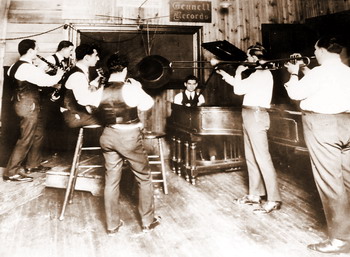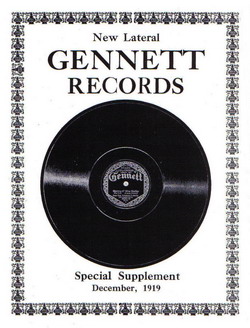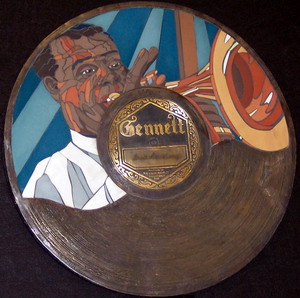|
Why the Difference Is in the Tone:
The Starr-Gennett Legacy
By Elizabeth Surles
Bailey’s Lucky Seven recording at Starr-Gennett’s
New York studios, date unknown

|
|
Many members of the Canadian
Antique Phonograph Society support
the efforts of the Starr-Gennett
Foundation, located in Richmond, Indiana,
and the Foundation is grateful for their
support. Richmond is the former home of
the headquarters for the Starr Piano Company
and its recording division, commonly called
Gennett Records. Starr Piano’s story is most
frequently remembered for the company’s
significant contributions to the history of jazz
music. The Starr-Gennett Foundation seeks to
promote and preserve not only this important
jazz legacy, but also the many other parts of
the Starr-Gennett legacy, including some very
significant Canadian connections. The Starr
Piano Company’s role in the establishment of
the phonograph and record industry in Canada
and the United States as well as Starr’s role
in the development and spread of the blues,
old-time country, and gospel music do not
often bear mention in jazz history. For that
matter, many jazz histories do not note the
role of record labels, such as Gennett, in jazz’s
development until decades after the heyday of
Gennett in the 1920s. However, the legacy of
the Starr-Gennett enterprise can still be heard in
the popular music world of today.
The Starr Piano Company began as the small
Trayser Piano Company, which was launched
by George Trayser, Richard Jackson, and James
Starr in 1872. Building on the piano-building
expertise of George Trayser, a German-born
piano craftsman, James and Benjamin Starr
moved operations in the mid-1880s to the
Whitewater River Gorge, a spectacular geologic
feature in the middle of Richmond. The Starr
brothers came from one of Richmond’s original
Quaker families, which figured prominently in
Richmond’s early development.
As the Company grew, the Starr brothers
began to sell pianos through the Jesse French
Company, based in St. Louis, Missouri. Henry
Gennett, then vice-president of Jesse French,
and his father-in-law, John Lumsden, initiated
merger negotiations with James and Benjamin
Starr that resulted in the 1893 incorporation of
the Starr Piano Company, a new incarnation
of the earlier Trayser Piano Company. Starr
pianos gained an international reputation and
distribution, winning awards for their quality at
Chicago’s Columbian Exposition in 1893, the
St. Louis World’s Fair in 1904, and many other
international exhibitions.
Gennett Records catalogue, 1919

|
|
By 1897, Starr Piano Company stock had
doubled in value, and operations continued to
grow exponentially. The Starr Piano Company
was part of an elite group of American piano
manufacturers that controlled over 75 percent
of the booming piano market. Player pianos
and piano rolls were added to the product line
around 1906. The Starr Piano Company had
stores in nearly every major city and frequently
shipped pianos overseas. Starr’s Canadian
distribution branch, the Starr Sales Company,
became the Starr Company of Canada in 1918.
The Starr Company of Canada was created as
the Canadian recording division of the Starr
Piano Company, which had established a
recording division stateside only three years
before, in 1915, around the same time Starr
began to manufacture phonographs.
The newly formed Starr Company of Canada
quickly gained a subsidiary, Starr Phonograph
Company of Quebec in 1920. The Starr
Phonograph Company was created under the
supervision of Roméo Beaudry, an important
figure in the early production of Francophone
recordings in Canada. The Starr Piano
Company’s Canadian subsidiaries do not appear
to have remained under the supervision of the
company headquarters in Richmond beyond
1925, when the Compo Company bought the
Canadian Starr label, which continued to be
released after its purchase by Compo.
The Compo Company, founded by Herbert
Berliner in 1918, pressed Starr’s American
masters to issue Gennett recordings in Canada
(and thus eliminated costly customs fees for
Starr) beginning in 1919. Roméo Beaudry
was a friend of Herbert Berliner, and Berliner
permitted Beaudry to use recording facilities
owned by Berliner to record Francophone
artists including J. Hervey Germain and
Hector Pellerin, among others, for a Gennett
Francophone series. Starr Piano’s Canadian
division was issuing recordings made both
in the States and in Canada, if only for a few
short years. But these preliminary connections
between the Starr companies in Canada and
the United States indicate the role that the
Starr Piano Company played in the developing
phonograph and record industry in Canada.
Meanwhile, Starr Piano was booming in the
States. After the death of John Lumsden in
1898 and Benjamin Starr in 1903, Henry
Gennett assumed leadership of the prosperous
company. Henry Gennett’s oldest son,
Harry, was Vice-President, and his middle
son, Clarence, was treasurer. Fred Gennett,
the youngest of Henry’s three sons, was
employed as secretary. Under Henry Gennett’s
entrepreneurial and visionary leadership, the
Starr Piano Company and Gennett family
would capture some of the earliest recordings of
American musical pioneers who were bringing
to life indigenous styles of American popular
music, including jazz, blues, and old-time
country.
Given Richmond’s close proximity to Chicago
and the construction of a
Gennett recording studio
in New York City, Gennett
Records had easy access to
the legendary musicians who
helped define early jazz music.
In the 1920s, the Gennett
label would record practically
any musician, regardless of
race, who might produce a
profitable record. As a result,
Gennett Records offered the
very first issued recordings
of a host of jazz innovators
including Louis Armstrong,
Joe "King" Oliver (and his Creole Jazz Band),
Duke Ellington (purportedly), the New Orleans
Rhythm Kings, Bix Beiderbecke, Earl Hines,
and Hoagy Carmichael. Other important jazz
artists who recorded for the label, often very
early in their careers, include Jelly Roll Morton,
Mary Lou Williams, Sidney Bechet, Johnny
and Baby Dodds, Fletcher Henderson, Muggsy
Spanier, Red Nichols, Artie Shaw, Miff Mole,
Jimmy Durante, Jimmy and Tommy Dorsey,
Fats Waller, Freddie Keppard, Jimmy Noone,
and Coleman Hawkins. Richmond earned the
renown of being the "cradle of recorded jazz"
due to Gennett Records.
Louis Armstrong Marker,
Gennett Records
Walk of Fame

|
|
Beyond the emergence of jazz, the 1920s
witnessed the popularization of another unique
American style of popular music—the blues.
Some of the most notable blues musicians to
record for the Gennett label include Jaybird
Coleman, Roosevelt Sykes, Viola McCoy,
Johnny Watson (Daddy Stove Pipe), Long Cleve
Reed, Charles Davenport, Tommie Bradley,
Scrapper Blackwell, the Mississippi Sheiks,
Sleepy John Estes, and Cryin’ Sam Collins. A
performer known as "Georgia Tom" also made
several blues records for Gennett, but many
people know "Georgia Tom" as Thomas A.
Dorsey, the recognized father of modern gospel
music. Additionally, Gennett recorded sides in
Richmond at $40 apiece for
the Paramount label in 1929,
when Paramount’s new studio
was under construction.
These sessions captured two
of the eminent names in
blues history—Blind Lemon
Jefferson and Charley Patton.
As the catalog of recordings
expanded, the Gennetts
introduced new subsidiary
labels to encompass this wide
variety of musical styles and
also to increase distribution
to new markets. The Champion label, initiated
in 1925, was created to supply rural and chainstore markets. The red Champion label featured
many re-releases of records originally issued
on the Gennett label, often using a pseudonym
for the artist or group to avoid paying the
musicians’ royalties. Fred Gennett, head of
the recording division, helped establish the
Black Patti label in 1927 to capitalize on the
popularity of Gennett’s race records. Only
55 Black Patti recordings were ever released.
Several Black Patti recordings were also
reissued on other Gennett labels, using artist
pseudonyms like the Champion reissues. Other
subsidiary labels included Silvertone, Superior,
Supertone, Challenge, Conqueror, Bell, and
Buddy. Many of these other subsidiary labels
were recorded and pressed by Gennett for
companies like Sears, Roebuck and Co.
Gennett began to release old-time country
music in earnest in 1925. Like the blues, oldtime country was more noticeably emerging
as commercial music during the 1920s and
was specifically marketed to a rural audience
through the chain stores and mail order catalogs
that featured Gennett’s Champion label, among
other Gennett subsidiary labels. Gene Autry is
the most-recognized early country performer
to record for the label and today is most
remembered for his reputation as the "Singing
Cowboy," but when Autry recorded for Gennett,
he frequently emulated Jimmie Rodgers’
"blue yodel" style. Other important old-time
musicians who recorded for the label include
Doc Roberts, the Tweedy Brothers, Bradley
Kincaid, Uncle Dave Macon, Da Costa Woltz’s
Southern Broadcasters, Ernest Stoneman, and
many more. Gennett would release old-time
country music until 1934, when the company
discontinued the Champion label. Over 320 oldtime country recordings were released between
1925 and 1934.
The Starr Piano Company continued to
manufacture pianos until 1949 and diversified
its product offerings beyond music in the
1930s to include refrigerators and refrigeration
supplies, which were sold around the U.S. In
1952, the J. Solotken Company of Indianapolis
bought the Starr Piano Company and the
company’s assets in an auction later that year.
The Whitewater River Gorge, once bustling
from over 75 years of piano production and the
new sound of pioneering musicians echoing in
the air, was now silent. Yet the legacy of Starr
Piano and Gennett Records and the impact
they had on Canada’s and America’s musical
heritage lives on.
Tangible reminders of the remarkable StarrGennett legacy still exist – recordings made
at the Gennett Studios, artists’ letters and
memoirs, pianos manufactured in the Starr
factories, buildings associated with Starr Piano
and the Gennett family, and memorabilia
including record catalogs, historic photographs,
and advertising posters. The Starr-Gennett
Foundation’s mission has focused on locating
and acquiring artifacts to document and
preserve this important part of Richmond’s
heritage. Now the Starr-Gennett Foundation will
use these stories, artifacts and buildings to bring
the Starr-Gennett legacy to life.
The Foundation’s interpretive plans will engage
both visitors and residents in experiencing the
Starr-Gennett legacy. Plans include:
-
Gennett Records Walk of Fame – The
first ten markers in the Gennett Walk of
Fame will be unveiled at a free festival on
September 8, 2007, and will be located along
South 1st Street in Richmond at the site
of the Starr Piano Company. Markers are
three-dimensional, cast bronze and colored
tile mosaic emblems in the form of 78 rpm
phonograph records. Each marker features
a Gennett or subsidiary label design and an
artistic mosaic rendering of the represented
musician. The Foundation’s National
Advisory Board selected the first 20 nominees,
and the second ten markers will be unveiled in
July, 2008.
-
Audio tour CD, guidebook and interpretive
signage – This tour will be highlighted by
music recorded by Gennett Records and will
showcase important locations in Richmond
that have connections to the Starr-Gennett
story.
-
Satellite exhibits – Artifacts and pictures
will be presented in small exhibits at locations
throughout Richmond to encourage visitors to
explore the city and enjoy the discovery of the
Starr-Gennett story. The first of these satellite
exhibits was installed in Richmond in May,
2007.
-
Starr Gennett Music Festival – Honoring
Richmond’s musical heritage, this festival is
planned to become a signature event for the
city.
-
Starr-Gennett Interpretive Center – The
centerpiece of the Foundation’s plans, the
interpretive center will feature interactive
exhibits depicting Richmond in the early
20th century and telling the stories of StarrGennett’s production of pianos and records.
Starr-Gennett Foundation Accomplishments
-
The Foundation has collected over 1,000 artifacts
related to the Starr-Gennett legacy including
photographs, paper items, phonograph records
(over 900), pianos, phonographs and more.
-
The Foundation is working on digitizing Gennett
recordings to be part of a free online archive
and has secured several grants from the Wayne
County Foundation, the GRAMMY Foundation,
and the Indiana State Library of more than
$70,000 to assist with this process. The archive
will be up and running in summer, 2007.
-
The Foundation has completed an oral history
project with grants from the Wayne County
Foundation and the Indiana Humanities Council
that was presented in a traveling panel exhibit
as part of Richmond’s Bicentennial Celebration.
Select interview transcripts from this project are
available via the Foundation’s website.
-
The Foundation supports the discographical
research of Professor Charles Dahan and T.
Malcolm Rockwell as they work to compile a
master Gennett discography.
-
Sam Meier worked with the Foundation and
Wayne County Historical Museum to produce a
set of CDs and a booklet featuring information
and historic photos about Gennett Records. This
CD set is being marketed by the Foundation
with other memorabilia being produced by the
Foundation.
-
A walking tour booklet featuring sites connected
to the Starr-Gennett legacy has been published
by the Foundation.
-
The Foundation offers a small but free exhibit
of various artifacts titled "The Difference Is In
the Tone" at Charlie’s Coffee Bar and Gallery in
Richmond.
-
Successful music events such as the July,
2005, Gennett Roots Revealed concert and The
Untouchable Times Weekend Getaway have
been offered. The "Country Blues and Gennett
Records" event attracted over 600 people in
October, 2004, at Earlham College’s Goddard
Auditorium.
-
The Foundation issues a new "Gems from
the Gennett Studios" CD every year as a
membership premium.
-
Working with the City of Richmond, the
Foundation has helped with development of the
former site of the Starr Piano Company through
the creation of temporary interpretive signs and
the stabilization of the "parrot logo building."
-
The Foundation led efforts to create a driving
audio tour detailing Richmond’s history in
honor of the City’s Bicentennial. This audio tour
provides the groundwork for the creation of a
full-length audio tour devoted to Starr Piano and
Gennett Records.
For more information, sign up for the Foundation’s
free monthly e-newsletter at www.StarrGennett.
org or join the Foundation as a member.
Memberships begin at $35 (U.S. Dollars) and
include a subscription to the bi-annual, eight-page
Starr-Gennett News. Club level memberships,
beginning at $50, include subscription to the
News, a free copy of the booklet History of the
Whitewater Gorge, a copy of the annual "Gems
from the Gennett Studios" CD, and a 15%
discount on Foundation merchandise. Many
promotional items are available through the
Foundation’s website and office, including t-shirts
with the Gennett Records’ parrot logo, books such
as Rick Kennedy’s history Jelly Roll, Bix, and
Hoagy, and other gifts and memorabilia. Music
includes Sam Meier’s CD compilations of rare
Gennett material, available as three separate CDs
or in a boxed set of three with a booklet by Meier,
Duncan Schiedt, and Tom Graves, former Project
Coordinator.
To contact the Foundation:
Starr-Gennett Foundation
33 South 7th Street
Richmond, IN 47374 USA
www.starrgennett.org
Email: Info@StarrGennett.org
Phone: (765) 962-1511, ext. 104
Fax: (765) 966-0882
|